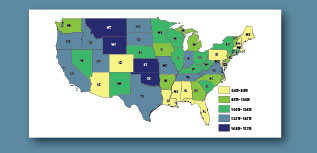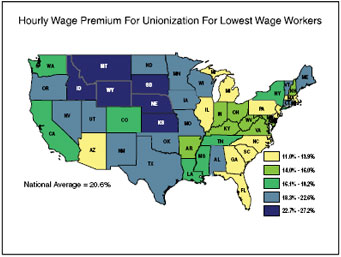| Unionized workers earn 11.9% more, on average, than non-union workers with similar characteristics, according to research reported by the Center for Economic and Policy Research in Washington, D.C. Adding a typical benefits load of 30%, the union premium grows to 15.5%. |
| |
| The Center’s research is consistent with other studies that place the union wage premium at somewhere between 10% and 20%. What’s unique about this analysis, however, is that it stratifies workers by wage category, and estimates the union wage premium for low, moderate and high wage workers. |
| |
| For example, the study estimates unionization raises the wages of low-wage workers (i.e., those in the 10th percentile) by 20.6%. As wages increase, the wage impact of unionization diminishes, adding only 6.1% to the highest wage group. |
| |
| The study also provides state-by-state comparisons of the union wage premium at various wage levels. As one might expect given the Southeast’s reputation as a lower wage region, the union impact on wages is small relative to the Midwest and West. The union premium is below 10.4% in most of the Southeast, but more than 12.7% in most states west of the Mississippi River. |
| |
| Of note among the southern states is Alabama. While the unionization wage impact is among the lowest when considering workers in all wage ranges together, with an 8% premium, carving out the lowest wage workers shows the state has a much higher unionization premium for this group, estimated at 21.4%. |
| |
|
|
 |
| [Place cursor over map to enlarge] |
| |
 |
|